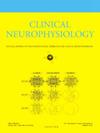加速间歇性θ波爆发经颅磁刺激背外侧前额皮质治疗慢性膝骨关节炎疼痛。
IF 3.6
3区 医学
Q1 CLINICAL NEUROLOGY
引用次数: 0
摘要
目的:本研究评估了加速间歇性θ波爆发刺激(aiTBS)的可行性、安全性和耐受性,并结合有效的连接引导,从右前岛(rAI)靶向左背外侧前额叶皮质(lDLPFC)治疗慢性膝骨关节炎疼痛。方法:BoostCPM临床试验(ISRCTN15404076)是一项随机、假对照、单盲、平行组的试点研究,在轻中度慢性疼痛患者中进行。参与者被分配为2:1(活动:假)aiTBS连续4天(共36,000次脉冲),每日剂量为9000次脉冲(5次1800次脉冲)。主要结果包括安全性、耐受性、疼痛相关和情感结果以及定量感觉测试。结果:45名参与者接受了积极的(n = 33)或假的(n = 12) aiTBS。无严重不良事件记录,治疗组和假手术组的方案依从性(耐受性)分别为80.6%和100%。随访有效率为78.1%,总体接受/满意度为89%。治疗后立即观察到疼痛缓解,持续16周,临床有意义的疼痛负担减轻,但组间无差异。结论:rai连接lDLPFC靶向的aiTBS对慢性疼痛患者是一种安全、耐受性良好、可行且可接受的干预措施。然而,与假手术相比,我们没有发现额外的改善。意义:aiTBS和lDLPFC靶向疼痛缓解的进一步研究是必要的。本文章由计算机程序翻译,如有差异,请以英文原文为准。
Accelerated intermittent theta burst transcranial magnetic stimulation of the dorsolateral prefrontal cortex for chronic knee osteoarthritis pain
Objective
This study assessed feasibility, safety, and tolerability of accelerated intermittent theta burst stimulation (aiTBS) with effective connectivity-guidance targeting the left dorsolateral prefrontal cortex (lDLPFC) from the right anterior insular (rAI) in chronic knee osteoarthritis pain.
Methods
The BoostCPM clinical trial (ISRCTN15404076) was a randomized, sham-controlled, single-blind, parallel-group pilot study in patients with mild-moderate chronic pain. Participants were assigned 2:1 (active: sham) aiTBS for 4 consecutive days (totaling 36,000 pulses) at a daily dose of 9000 pulses (5 sessions of 1800 pulses). Primary outcomes included safety, tolerability, pain-related and affective outcomes, and quantitative sensory testing.
Results
45 participants received active (n = 33) or sham (n = 12) aiTBS. No serious adverse events were recorded, and protocol adherence (tolerability) was 80.6 % and 100 % for active and sham. Follow-up response rate was 78.1 % and overall acceptance/satisfaction was 89 %. Pain relief was observed immediately after treatment and lasted 16 weeks with clinically meaningful reduction of pain burden, but no differences between groups.
Conclusions
aiTBS with rAI-connected lDLPFC targeting is a safe, well tolerated, feasible, and acceptable intervention in chronic pain patients. However, we found no additional improvements compared to sham. Significance: Further studies of aiTBS and lDLPFC targeting for pain relief are warranted.
求助全文
通过发布文献求助,成功后即可免费获取论文全文。
去求助
来源期刊

Clinical Neurophysiology
医学-临床神经学
CiteScore
8.70
自引率
6.40%
发文量
932
审稿时长
59 days
期刊介绍:
As of January 1999, The journal Electroencephalography and Clinical Neurophysiology, and its two sections Electromyography and Motor Control and Evoked Potentials have amalgamated to become this journal - Clinical Neurophysiology.
Clinical Neurophysiology is the official journal of the International Federation of Clinical Neurophysiology, the Brazilian Society of Clinical Neurophysiology, the Czech Society of Clinical Neurophysiology, the Italian Clinical Neurophysiology Society and the International Society of Intraoperative Neurophysiology.The journal is dedicated to fostering research and disseminating information on all aspects of both normal and abnormal functioning of the nervous system. The key aim of the publication is to disseminate scholarly reports on the pathophysiology underlying diseases of the central and peripheral nervous system of human patients. Clinical trials that use neurophysiological measures to document change are encouraged, as are manuscripts reporting data on integrated neuroimaging of central nervous function including, but not limited to, functional MRI, MEG, EEG, PET and other neuroimaging modalities.
 求助内容:
求助内容: 应助结果提醒方式:
应助结果提醒方式:


